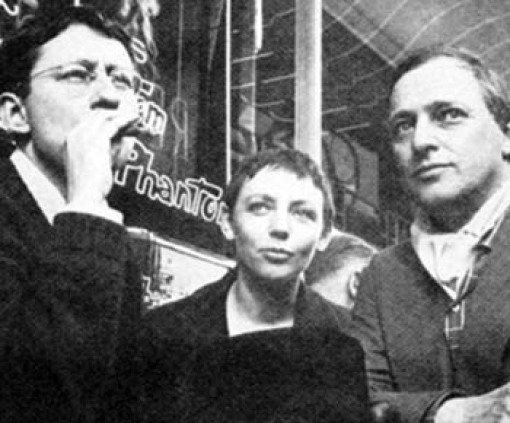Home >> Reviews >> Books >> 2011 >> Sep >> Books: The Beach Beneath the Street: The Everyday Life and Glorious Times of the Situationist International. McKenzie Wark
Books: The Beach Beneath the Street: The Everyday Life and Glorious Times of the Situationist International. McKenzie Wark

Published: 15 September 2011
by KATE WEBB
IT'S hardly surprising that as politicians rely increasingly on intermediaries – think tanks, pollsters and spin doctors – alienation from the political mainstream grows and people look elsewhere for ideas about how to organise themselves.
In Britain, there’s the unorthodox campaigning of UK Uncut, the revived student movement, the growth of local activism and international solidarity groups, flash-mobs and even the riots (all empowered by social media).
A mass opposition movement has yet to emerge – indeed, it may no longer be the goal – but against the background of economic meltdown and global uprisings, something is stirring.
If you’ve been wondering whose ideas are swimming around in the heads of these people (whether they know it or not) you might dip into The Beach Beneath the Street, McKenzie Wark’s new history of the Situationist International, that band of avant-garde artists, manifesto-writers, drifters and plagiarists whose example helped ignite the last global revolt of youth in 1968.
The Situationists emerged from the historical ambiguities of post-war Europe, when mass death, collaboration and deracination were quickly paved over with advertising, popular music and shiny white goods. Many of the disenchanted gravitated to Paris’s bohemian quarter, to the cafés and clubs of St Germain.
Here Guy Debord, a student from the provinces, began hanging out with “delinquents”, street kids getting by as prostitutes or thieves. (Wark rather grandly calls this “street ethnography”.)
What interested Debord was not so much the individuals he met as how their way of living at the edge of things might present a challenge to the enveloping commodification of life.
In The Society of the Spectacle, 1967, a thesis influenced by Marx and partly appropriated from Hegel, he describes “the decline of being into having” under capitalism, and how its media obscures the fact that all relations are now relations of property.
“Never Work!,” Debord proclaimed, daubing the idea over the walls of Paris.
Brilliant at coining slogans – “Divided we stand”, “Remember, you are sleeping for the boss”, “The beach beneath the street” – the Situationist provocation was to unthinking acceptance of life as capitalism ordained it, particularly the division of time and space into functional portions for work, leisure and sleep.
The challenge was to construct “situations”, tenuous and fluid, that imagined things otherwise, that broke the hold of “mindless form” by amplifying the potential of messy, contradictory everyday life.
This had to be done without directly opposing – because to oppose is to legitimise – and while circumventing as far as possible capitalism’s great propensity for “recuperating” any opposition. A further instruction was: “Be at war with the world, but lightly.”
The not inconsiderable difficulty of the task was no doubt part of the attraction.
A strong emphasis was placed on strategy, tactics and game-playing; much Situationist discourse was couched in the language of war (Debord’s board game, Le Jeu de la Guerre, created with Alice Becker-Ho; Michèle Bernstein’s novels about emotional gamesmanship); and throughout its 15-year existence there were countless estrangements, splits and expulsions.
Before Debord called time in 1972, out of all this fighting the Situationists came up with some valuable and long-lasting ideas.
A principal one is the “turn”: wrong turns taken in history that might usefully be revisited (Wark’s book can be seen in this spirit); or détournement, a turn against an already existing work – call it recycling or defiguring with intent, a way of interrupting the seamless flow of the Spectacle, that adds to the conversation while also subverting it.
Asger Jorn, the Danish “spontaneous-abstract” painter, was most commercially successful at this, achieving international acclaim in the late 1950s.
His success meant Jorn could be a provider of “the gift” – something anthropologists have long studied, but of interest to Situationists because of its potential to disrupt commodity relations.
From the sale of his paintings Jorn funded the International. He also donated a gallery at Silkeborg, housing his work together with that of other leading Modernists, which he obtained by swapping.
Today, Situationist thinking on the gift, cultural sharing and copyright influences debates about intellectual property and creative commons; their notion of the dérive – “calculated drifting” – runs into the ambulatory musings of Iain Sinclair, Peter Ackroyd and Will Self; their preoccupation with art and technology (“industrial art”) was echoed in recent Google-led discussions; and their analysis of rioting (Debord wrote about Watts) as a logical response to the Spectacle, has been much referred to of late.
“Our ideas are on everyone’s mind,” the Situationists boasted in the 1960s, and half a century later they are once again.
Perhaps the keenest Situationist insight concerns the sense of futility and boredom in modern urban living.
But in an alienated, all too knowing world absent of God, art and revolution, Wark’s book dares us to keep our spirits up, asking us to think about how to maintain creative resistance, how to keep fidelity with some detournéed idea of the Marxist and Situationist past, and, following their goal of ideas in action, how best to practise our passionate “solidarity without faith”.
• The Beach Beneath the Street: The Everyday Life and Glorious Times of the Situationist International. By McKenzie Wark. Verso, £14.99




Comments
Post new comment